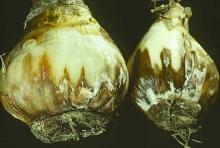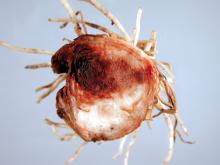Cause Fusarium oxysporum f. sp. narcissi, a soilborne fungus that can remain viable for at least 10 years. Basal rot principally affects daffodil bulbs in storage or transit but may develop during later growth stages in the field where bulb yield is reduced. Infection occurs as new roots are emerging and when old roots are dying down or when there is mechanical damage. Root infection and disease development are related to soil temperatures above 55°F. Bulb-to-bulb spread is more important than soilborne inoculum. Excessive nitrogen fertility increases incidence of basal rots, splits, and bruises. Warm storage conditions also favor disease development. The cultivars Carlton, Golden Ducat, Golden Harvest, and Dutch Master are susceptible.
Symptoms After planting roots may fail to emerge or may emerge but then become dark colored. Small dark spots may develop on the basal plate. The disease usually begins in the root plate at the base of the scales and spreads through the bulb, generally attacking the central portion first. After infection, the rot extends more rapidly within the scale than across the faces of successive scales, but the fungus can spread in all directions. In partly resistant cultivars, the rot tends to advance in streaks and layers with layers of healthy tissues intervening. Rotted tissue is chocolate or purplish brown. The mycelium appears as a weft of whitish pink threads between the scales. Bulbs become soft, dehydrated, brittle, and then mummified. Shoots from infected bulbs are short lived and crooked while foliage is weak and senesces prematurely. Usually there is no slimy or mushy breakdown.
Cultural control
- Disinfect cutting knives, containers, and equipment.
- Dig bulbs as early as practical before soil temperatures rise to far; keep them as dry as possible.
- Prevent sunburning, bruising, and wounding.
- Discard diseased bulbs or any that are soft, lightweight or damaged.
- Store bulbs in thin layers under cool (55°F to 60°F) and well-ventilated conditions with good air circulation.
- Rotate out of daffodils for 8 years or more if practice.
- Reduce planting density in infected stocks.
- Avoid high rates of nitrogen.
- Plant in cool, well-drained soil as deep as practical. Plant when soil temperatures fall below those in storage.
Chemical control Fungicide treatment must be integrated with cultural-control tactics.
- A preplant bulb soak only after all bulbs have been sorted and diseased bulbs have been destroyed.
- 42-S Thiram at 1.5 pints/8 gal water. 24-hr reentry.
- Daconil Ultrex at 2.5 to 5 lb/100 gal water. Soak sorted bulbs for 15 min. Good control. 12-hr reentry.
- KleenGrow at 0.15 to 1.5 fl oz/gal water. Soak for 30 seconds and allow to drain.
- Medallion WDG at 8 oz/100 gal water. Soak sorted bulbs for 20 min. 12-hr reentry.
- Postharvest soak.
- Aldesan Microbiocide at 2 fl oz/gal of water and heat to 110°F to 111°F for 4 hours. Change dip tank water when it becomes discolored or when sediment is present. Dip dank wastewater may be applied to bulb fields when rain is not expected for 24 hours. Washington only. SLN WA-160001b. Formaldehyde Solution 37 is also registered with SLN WA-160001.
- Medallion WDG at 8 oz/100 gal water. Soak sorted bulbs for 20 min then dry. 12-hr reentry.
- Mertect 340 F at 30 fl oz/100 gal water. Temperatures should be between 55°F and 75°F. Soak bulbs 15 to 30 min. within 48 hours after digging, then let dry.
Note Cleary's 3336 has not provided effective control in laboratory studies. OHP 6672 is a similar product.
Biological control Mycostop or LALStop K 61 (Streptomyces Strain K61) is registered. Research at WSU-Puyallup showed it provided a low level of control and was not as good as current chemical controls. O
Reference Chastagner, G.A. and Riley, K. L. 2002. Potential use of chlorine dioxide to prevent the spread of Fusarium basal rot during the hot water treatment of daffodil bulbs. Act Hort. 570:267-272.



